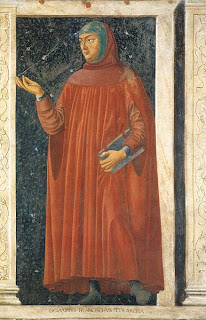 |
| Vishnu woke up to find himself surrounded by high mountains. |

Or so some people say. Others claim the Himalaya was created by jostling and collision of giant plates making up the surface of the Earth. India was once an island near Australia. About 200 million years ago, it began moving north, traveling as much as 9 cm per year ... racing right along! It eventually collided with Asia, destroying the Tethys Sea in the process (the one Vishnu swallowed in a single gulp). Though its speed has slowed to only 18 mm per year, India keeps moving northward. As it presses against and is shoved under Asia, the Himalaya continues to rise.
Right: India races north and collides with Asia, creating the Himalaya in the process. This seemingly-fanciful story happens to be true! Diagram courtesy USGS.
The topic for Accretionary Wedge #52, hosted by Shawn of the Vi-Carius Geology Blog, is dream courses -- geology courses we would like to see offered at our universities. My recommendation for the University of Wyoming is “Geology, History and Legend”, perhaps with a catchy subtitle like “the gods must be angry”. This would be an opportunity to introduce non-geologists to the subject, using the roles the Earth has played in our stories, and the stories we have come up with to explain what the Earth has done. It would be for non-majors, interested majors, and in fact anyone in the community. That community could be worldwide if the course were offered online (I think it would work well online).
The most appealing topics would be short-lived, dramatic, newsworthy events such as volcanoes, earthquakes, tsunamis, landslides and the like. Some have or may have figured prominently in the course of human history.
 |
| Santorini Island, Greece. |
The eruption of the Santorin volcano during the Bronze Age (ca 1500 BC) destroyed much of Santorini leaving a dramatic caldera, visible in the photo. The event may have been a factor in the collapse of Minoan Civilization, and also has been linked to the Atlantis myth.
The Dark Ages may have been caused in part by catastrophic volcanism. Ice cores and tree rings suggest as much. But no volcanoes have been found to explain the Mystery Cloud of 536, which darkened the skies of Europe.
“And it came about during this year that a most dread portent took place. For the Sun gave forth its light without brightness, like the Moon, during this whole year ... And from the time when this thing happened men were free neither from war nor pestilence nor any other thing leading to death.” (Procopius of Caesarea, ca 536/7; from Oppenheimer 2011).
Right: The Italian scholar Petrarch came up with the term “Dark Ages” for cultural deterioration during post-Roman times. Source.
Bacobaco, a giant turtle, was behind an eruption of the volcano Pinatubo long long ago. If folks had paid attention to legend, the destructiveness of the 1991 eruption wouldn’t have been such a surprise (see recent post).
 |
| Lyuba, a mummified baby mammoth from Siberia. |
Climate change, ice ages and continental-scale glaciation are harder to perceive at the human time-scale, but they can grip the public's interest even so. Maybe it’s because of our current concern for climate change, or maybe it's just the charisma of Pleistocene megafauna.
Given the slow pace of most geologic processes, is there a way to make them interesting, engaging? I think so -- by using landforms and features that are awesome, dramatic, surreal and easy to see and understand, like the Himalaya - plate tectonics example at the beginning of the post.
 |
| Qomolangma (Tibetan) or Sagarmāthā (Nepalese), aka Mount Everest, one of Hiranyaksha's giant piles of broken Earth. Photo by Lucag. |
Wyoming has many easy-to-see landforms and features created by uplift, erosion, extension, frost action, weathering, superpositioning of drainages, and on and on. The semi-arid climate ensures that they are not obscured by those detested plants! In the Wind River Canyon (above), a river cuts through a mountain range and changes its name in the process. Pleistocene periglacial relics can be seen in roadcuts and ditches. We have many Laramide anticlines and synclines, including the types -- the Laramie Mountains and Laramie Basin (below, click to view). Their structure often is quite clear from the ground.
And then there’s Devils Tower -- how much more dramatic can you get? Those gods must be pretty darn creative at times!
 |
| A small rock grew to save a band of people from a giant bear, which left claw marks on the sides. |
Ideas for my "dream course" came from recent readings:
Oppenheimer, C. 2011. Eruptions that shook the world. Cambridge University Press.
Vitaliano, D.B. 1973. Legends of the Earth, their geologic origins. Bloomington: Indiana University Press.





I would add Typhon the Titan, son of Gaia and Tartarus who when finally defeated by Zeus was trapped under Mount Etna. A giant with a hundred snake heads that scream with the sounds of different animals and eyes that glow red, mouths that breathe fire. His struggles to free himself from under the mountain cause earthquakes.
ReplyDeleteWow, that's awesome! especially the terrifying imagery ... "hundred snake heads that scream with the sounds of different animals ..." eegads!! Thanks, Pat.
DeleteThree young sisters were being attacked by a Bunyip, so their father magically turned them into stone to protect them - then he lost the magic bone he needed to turn them back. And in the Blue Mountains of New South Wales, Australia, the Three Sisters are still waiting...
ReplyDeleteAWESOME IDEA for a course! I would DEFINITELY enrol.
That's great, I love these myths, they're enchanting! ... and I would love to take such a course also. Thanks for reading.
Delete